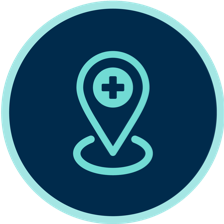The VYVGART Doctor Discussion Guide can be used to help you discuss with your neurologist current anti-AChR antibody positive gMG symptoms you have and how they impact your daily abilities.
About VYVGART
What is VYVGART?
VYVGART is the first FDA-approved treatment that uses a fragment of an IgG antibody to treat adults with anti-AChR antibody positive generalized myasthenia gravis (gMG). VYVGART is given in treatment cycles of a 1-hour infusion each week for 4 weeks (4 infusions total). Your neurologist will work with you to help determine if and when you need another treatment cycle, with the aim to help manage your symptoms.*
AChR=acetylcholine receptor; IgG=immunoglobulin G
*If additional cycles are needed.
How is VYVGART pronounced?
VYVGART is pronounced VIV-gart.
How does VYVGART work?
VYVGART is specifically designed to attach to and block the neonatal Fc receptor (FcRn), resulting in the reduction of IgG antibodies, including the harmful AChR antibodies that cause gMG symptoms.
Is VYVGART right for me?
Talk to your neurologist to see if VYVGART is right for you. The VYVGART Doctor Discussion Guide can be used to help you discuss with your neurologist current anti-AChR antibody positive gMG symptoms you have and how they impact your daily abilities.
Is VYVGART intended to be taken with other medications?
Yes, in the clinical trial, participants stayed on their current gMG treatment while receiving VYVGART. Talk to your doctor about the medications you are taking as part of your treatment plan.
What results did people see with VYVGART?
When added to their current gMG treatment, VYVGART helped clinical trial participants with anti-AChR antibody positive gMG achieve improved daily abilities. 68% (44 of 65) of participants on VYVGART achieved significant improvement in their ability to perform daily activities.†
†Improvement maintained for 4 or more weeks was measured by a decrease of 2 or more points on the Myasthenia Gravis Activities of Daily Living (MG-ADL) scale, with the first reduction occurring no later than 1 week after the last infusion of treatment cycle 1. The MG-ADL scale assesses the impact of gMG on daily functions by measuring 8 signs or symptoms that are commonly affected in gMG. Each item is measured on a 4-point scale, where a score of 0 represents normal function and a score of 3 represents the loss of ability to perform that function. Total scores range from 0 to 24 points, with a higher score showing more severe gMG.
What are the most common side effects of VYVGART?
In 84 clinical trial participants treated with VYVGART, the most common side effects included respiratory tract infection (33%), headache (32%), urinary tract infection (10%), tingling sensation (7%), and muscle pain (6%).‡
Most infections in participants on VYVGART were mild to moderate. Additionally, more patients on VYVGART vs placebo had blood side effects that were mild to moderate.
‡In ≥5% treated with VYVGART and more frequently than placebo.
Do I have to get any vaccines before taking VYVGART?
Discuss with your doctor when you need to receive age-appropriate vaccines before starting a new treatment cycle with VYVGART. Some types of vaccines are not recommended while taking VYVGART. Be sure to talk to your doctor about vaccines before starting any treatment cycle of VYVGART.
How many of the trial participants continued on to the extended safety study?
After the clinical trial, 91% of the clinical trial participants who were eligible chose to enter a 3-year extension safety study where they would receive VYVGART. These participants could have received, in addition to their current gMG treatment, either VYVGART or placebo in the original trial.
Dosing and infusions
How is VYVGART administered?
VYVGART is an infusion treatment, meaning it goes through an intravenous (IV) line put into a vein in your arm. Learn more about infusion treatment
How often do I need to get VYVGART?
VYVGART is given in treatment cycles with a break between each cycle.§ A treatment cycle consists of a 1-hour infusion each week for 4 weeks (4 infusions total). Your neurologist will work with you to help determine if and when you need another treatment cycle, with the aim to help manage your symptoms.§ In the clinical trial, the average time between the first infusion of the first treatment cycle and the first infusion of the second treatment cycle was 94 days.‖
§If additional cycles are needed.
‖The minimum time between treatment cycles in the clinical study was 50 days.
How long is a VYVGART infusion?
Your infusion may take approximately 1 hour. During this time, a doctor or nurse will monitor you for any reactions.
What should I do if I miss an infusion?
If you miss a scheduled infusion, VYVGART may be administered up to 3 days after the scheduled infusion day. Work with your neurologist to reschedule your next infusion.
Symptom tracking
Why do I need to track my symptoms?
Track your symptoms to help your neurologist determine your next treatment cycle. After starting VYVGART, track your symptoms each week and keep your neurologist up to date. See how symptom tracking works
How do I track my symptoms?
Download the MG-ADL assessment tool to start tracking your symptoms. If you are enrolled in My VYVGART Path, a physical journal will be mailed to you and a Nurse Case Manager can show you how to use it as you get started.
How often do I need to track my symptoms?
Track your symptoms regularly. If you track them weekly, try to do it at the same time each week. Be sure to share this information with your neurologist as it may help them determine your next VYVGART treatment cycle.
Patient support
What is My VYVGART Path?
My VYVGART Path is a Patient Support Program that provides personalized support from a Nurse Case Manager and committed support team.
Find out how we can help
How do I join the My VYVGART Path program?
After you and your neurologist decide on VYVGART, your doctor’s office will be able to enroll you in My VYVGART Path. Then, a Nurse Case Manager will call, welcome you to the program, and offer assistance as you get started with VYVGART on your treatment journey.
How can a Nurse Case Manager help me during treatment with VYVGART?
Nurse Case Managers are knowledgeable about gMG and VYVGART and are dedicated to listening to you and helping you navigate your VYVGART treatment journey. They can help you understand your VYVGART treatment, feel empowered with resources and information, navigate the insurance process, and understand potential financial assistance programs.
See how Nurse Case Managers can help
Additional resources
¶Your neurologist and insurance company will determine where you can receive your infusions.
Do not use VYVGART if you have a serious allergy to efgartigimod alfa or any of the other ingredients in VYVGART. Do not use VYVGART HYTRULO if you have a serious allergy to efgartigimod alfa, hyaluronidase, or any of the other ingredients in VYVGART HYTRULO. VYVGART and VYVGART HYTRULO can cause serious allergic reactions and a decrease in blood pressure leading to fainting.
VYVGART and VYVGART HYTRULO may cause serious side effects, including:
- Infection. VYVGART and VYVGART HYTRULO may increase the risk of infection. The most common infections for efgartigimod alfa-fcab-treated patients were urinary tract and respiratory tract infections. Signs or symptoms of an infection may include fever, chills, frequent and/or painful urination, cough, pain and blockage of nasal passages/sinus, wheezing, shortness of breath, fatigue, sore throat, excess phlegm, nasal discharge, back pain, and/or chest pain.
- Allergic Reactions (hypersensitivity reactions). VYVGART and VYVGART HYTRULO can cause allergic reactions such as rashes, swelling under the skin, and shortness of breath. Hives were also observed in patients treated with VYVGART HYTRULO. Serious allergic reactions, such as trouble breathing and decrease in blood pressure leading to fainting have been reported with efgartigimod alfa-fcab.
- Infusion-Related Reactions. VYVGART and VYVGART HYTRULO can cause infusion-related reactions. The most frequent symptoms and signs reported with efgartigimod alfa-fcab were high blood pressure, chills, shivering, and chest, abdominal, and back pain.
Tell your doctor if you have signs or symptoms of an infection, allergic reaction, or infusion-related reaction. These can happen while you are receiving your VYVGART or VYVGART HYTRULO treatment or afterward. Your doctor may need to pause or stop your treatment. Contact your doctor immediately if you have signs or symptoms of a serious allergic reaction.
Before taking VYVGART or VYVGART HYTRULO, tell your doctor if you:
- take any medicines, including prescription and non-prescription medicines, supplements, or herbal medicines,
- have received or are scheduled to receive a vaccine (immunization), or
- have any allergies or medical conditions, including if you are pregnant or planning to become pregnant, or are breastfeeding.
What are the common side effects of VYVGART and VYVGART HYTRULO?
The most common side effects in efgartigimod-alfa-fcab-treated patients were respiratory tract infection, headache, and urinary tract infection. Additional common side effects with VYVGART HYTRULO are injection site reactions, including rash, redness of the skin, itching sensation, bruising, pain, and hives.
These are not all the possible side effects of VYVGART and VYVGART HYTRULO. Call your doctor for medical advice about side effects. You may report side effects to the US Food and Drug Administration at 1-800-FDA-1088.
What is VYVGART® (efgartigimod alfa-fcab) for intravenous (IV) infusion and what is VYVGART® HYTRULO (efgartigimod alfa and hyaluronidase-qvfc) for subcutaneous injection?
VYVGART and VYVGART HYTRULO are both prescription medicines, each used to treat a condition called generalized myasthenia gravis, which causes muscles to tire and weaken easily throughout the body, in adults who are positive for antibodies directed toward a protein called acetylcholine receptor (anti-AChR antibody positive).
Please see the full Prescribing Information for VYVGART and the full Prescribing Information for VYVGART HYTRULO, and talk to your doctor.
IMPORTANT SAFETY INFORMATION
Do not use VYVGART if you have a serious allergy to efgartigimod alfa or any of the other ingredients in VYVGART. Do not use VYVGART HYTRULO if you have a serious allergy to efgartigimod alfa, hyaluronidase, or any of the other ingredients in VYVGART HYTRULO. VYVGART and VYVGART HYTRULO can cause serious allergic reactions and a decrease in blood pressure leading to fainting.
VYVGART and VYVGART HYTRULO may cause serious side effects, including:
- Infection. VYVGART and VYVGART HYTRULO may increase the risk of infection. The most common infections for efgartigimod alfa-fcab-treated patients were urinary tract and respiratory tract infections. Signs or symptoms of an infection may include fever, chills, frequent and/or painful urination, cough, pain and blockage of nasal passages/sinus, wheezing, shortness of breath, fatigue, sore throat, excess phlegm, nasal discharge, back pain, and/or chest pain.
- Allergic Reactions (hypersensitivity reactions). VYVGART and VYVGART HYTRULO can cause allergic reactions such as rashes, swelling under the skin, and shortness of breath. Hives were also observed in patients treated with VYVGART HYTRULO. Serious allergic reactions, such as trouble breathing and decrease in blood pressure leading to fainting have been reported with efgartigimod alfa-fcab.
- Infusion-Related Reactions. VYVGART and VYVGART HYTRULO can cause infusion-related reactions. The most frequent symptoms and signs reported with efgartigimod alfa-fcab were high blood pressure, chills, shivering, and chest, abdominal, and back pain.
Tell your doctor if you have signs or symptoms of an infection, allergic reaction, or infusion-related reaction. These can happen while you are receiving your VYVGART or VYVGART HYTRULO treatment or afterward. Your doctor may need to pause or stop your treatment. Contact your doctor immediately if you have signs or symptoms of a serious allergic reaction.
Before taking VYVGART or VYVGART HYTRULO, tell your doctor if you:
- take any medicines, including prescription and non-prescription medicines, supplements, or herbal medicines,
- have received or are scheduled to receive a vaccine (immunization), or
- have any allergies or medical conditions, including if you are pregnant or planning to become pregnant, or are breastfeeding.
What are the common side effects of VYVGART and VYVGART HYTRULO?
The most common side effects in efgartigimod-alfa-fcab-treated patients were respiratory tract infection, headache, and urinary tract infection. Additional common side effects with VYVGART HYTRULO are injection site reactions, including rash, redness of the skin, itching sensation, bruising, pain, and hives.
These are not all the possible side effects of VYVGART and VYVGART HYTRULO. Call your doctor for medical advice about side effects. You may report side effects to the US Food and Drug Administration at 1-800-FDA-1088.
What is VYVGART® (efgartigimod alfa-fcab) for intravenous (IV) infusion and what is VYVGART® HYTRULO (efgartigimod alfa and hyaluronidase-qvfc) for subcutaneous injection?
VYVGART and VYVGART HYTRULO are both prescription medicines, each used to treat a condition called generalized myasthenia gravis, which causes muscles to tire and weaken easily throughout the body, in adults who are positive for antibodies directed toward a protein called acetylcholine receptor (anti-AChR antibody positive).
Please see the full Prescribing Information for VYVGART and the full Prescribing Information for VYVGART HYTRULO, and talk to your doctor.
Do not use VYVGART if you have a serious allergy to efgartigimod alfa or any of the other ingredients in VYVGART. Do not use VYVGART HYTRULO if you have a serious allergy to efgartigimod alfa, hyaluronidase, or any of the other ingredients in VYVGART HYTRULO. VYVGART and VYVGART HYTRULO can cause serious allergic reactions and a decrease in blood pressure leading to fainting.
VYVGART and VYVGART HYTRULO may cause serious side effects, including:
- Infection. VYVGART and VYVGART HYTRULO may increase the risk of infection. The most common infections for efgartigimod alfa-fcab-treated patients were urinary tract and respiratory tract infections. Signs or symptoms of an infection may include fever, chills, frequent and/or painful urination, cough, pain and blockage of nasal passages/sinus, wheezing, shortness of breath, fatigue, sore throat, excess phlegm, nasal discharge, back pain, and/or chest pain.
- Allergic Reactions (hypersensitivity reactions). VYVGART and VYVGART HYTRULO can cause allergic reactions such as rashes, swelling under the skin, and shortness of breath. Hives were also observed in patients treated with VYVGART HYTRULO. Serious allergic reactions, such as trouble breathing and decrease in blood pressure leading to fainting have been reported with efgartigimod alfa-fcab.
- Infusion-Related Reactions. VYVGART and VYVGART HYTRULO can cause infusion-related reactions. The most frequent symptoms and signs reported with efgartigimod alfa-fcab were high blood pressure, chills, shivering, and chest, abdominal, and back pain.
Tell your doctor if you have signs or symptoms of an infection, allergic reaction, or infusion-related reaction. These can happen while you are receiving your VYVGART or VYVGART HYTRULO treatment or afterward. Your doctor may need to pause or stop your treatment. Contact your doctor immediately if you have signs or symptoms of a serious allergic reaction.
Before taking VYVGART or VYVGART HYTRULO, tell your doctor if you:
- take any medicines, including prescription and non-prescription medicines, supplements, or herbal medicines,
- have received or are scheduled to receive a vaccine (immunization), or
- have any allergies or medical conditions, including if you are pregnant or planning to become pregnant, or are breastfeeding.
What are the common side effects of VYVGART and VYVGART HYTRULO?
The most common side effects in efgartigimod-alfa-fcab-treated patients were respiratory tract infection, headache, and urinary tract infection. Additional common side effects with VYVGART HYTRULO are injection site reactions, including rash, redness of the skin, itching sensation, bruising, pain, and hives.
These are not all the possible side effects of VYVGART and VYVGART HYTRULO. Call your doctor for medical advice about side effects. You may report side effects to the US Food and Drug Administration at 1-800-FDA-1088.
What is VYVGART® (efgartigimod alfa-fcab) for intravenous (IV) infusion and what is VYVGART® HYTRULO (efgartigimod alfa and hyaluronidase-qvfc) for subcutaneous injection?
VYVGART and VYVGART HYTRULO are both prescription medicines, each used to treat a condition called generalized myasthenia gravis, which causes muscles to tire and weaken easily throughout the body, in adults who are positive for antibodies directed toward a protein called acetylcholine receptor (anti-AChR antibody positive).
Please see the full Prescribing Information for VYVGART and the full Prescribing Information for VYVGART HYTRULO, and talk to your doctor.




